Dear Mom,
- Find health care and other services.
- Learn to make smart food choices.
- Learn ways to keep your baby safe.
- Get support with breastfeeding.
- Buy healthy foods.
WIC can help you learn more about healthy eating. WIC has nutrition sessions for you and other moms to learn, share ideas and ask questions. We hope you enjoy your experience with WIC; we are happy to share this special time with you.
Sincerely,
Your WIC staff
Get the Care You Need
Postpartum care is health care for women after their baby is born. A healthcare provider or specially trained nurse checks that you are healthy and healing well. Go to your postpartum checkups. Ask when you will need a checkup again.
You and your baby need immunizations to stay healthy.
- Most immunizations are given in the first 2 years. Some immunizations are needed after that.
- Ask your healthcare provider what immunizations you and your baby need.
- Get immunizations on time.
- Keep an immunization record for you and your baby. Bring the record with you to all appointments.
- Know your HIV status. Get tested. It’s free.
If you need help to pay for health care, contact your local Medicaid office.
Choose Healthy Foods
Moms who feed only human milk to their baby may need slightly more food. This is a general guide. You may need more or less amounts of food. For a Daily Food Plan that’s designed just for you, visit www.myplate.gov.
Eating nutritious, regular meals helps you:
- Have more energy.
- Think clearly.
- Heal better.
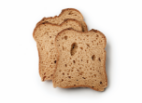
Breastfeeding:
Non-Breastfeeding:
1 Serving = 1 Ounce
Examples:
- 1 slice bread or tortilla
- ½ bagel or hamburger bun
- ½ cup cooked rice, noodles or cereal
- 1 cup flake-type cereal
Eat whole grains like:
- Oatmeal
- Whole wheat bread or rolls
- Brown rice
- Whole wheat pasta
- Tortillas (whole wheat or corn)
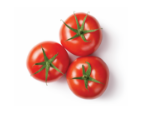
Breastfeeding:
Non-Breastfeeding:
1 Serving = ½ Cup
Examples:
- ½ cup cooked vegetables
- 1 cup raw vegetables
- 1 cup lettuce or other leafy greens
- ½ cup vegetable or tomato juice
Tips:
- Eat many kinds and colors: dark green, orange, red, yellow, purple, and white
- Add to: scrambled eggs, rice, noodles, salads, and casseroles
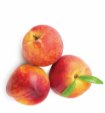
Breastfeeding and Non-Breastfeeding:
1 Serving = ½ Cup
Examples:
- ½ cup chopped or cooked fruits
- 1 fruit – apple, orange, peach, etc.
- ½ cup 100% fruit juice
- ¼ cup dried fruit
Tips:
- Eat many kinds and colors: red, yellow, orange, blue, green, purple, and white
- Put sliced or chopped fruit on cereal, pancakes, pudding, and frozen yogurt
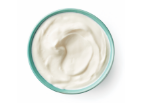
Breastfeeding and Non-Breastfeeding:
1 Serving = 1 Cup
Examples:
- 1 cup milk
- 1 cup yogurt
- 3 slices (2 ounces) American (processed) cheese
- 1½ ounces cheddar or similar cheese cup shredded cheese
- ½ cup cottage cheese
- 1 cup soymilk
Tips:
- Choose low-fat or non-fat milk
- A 1½ ounce serving of cheese is the size of 3-4 dice-sized cubes
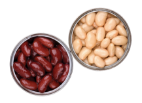
Breastfeeding:
Non-Breastfeeding:
1 Serving = 1 Ounce
Examples:
- 1 ounce meat, chicken, turkey, or fish
- ¼ cup canned light tuna
- 1 egg
- ¼ cup cooked beans or tofu
- 1 tablespoon peanut butter
Tips:
- A 3-ounce serving is the size of a deck of cards
- Choose lean meats – bake, broil, or grill them
- Beans are a great source of protein
Eat
Breakfast, Lunch, and Dinner
You and your baby do best when you eat regular meals and snacks. Here is a sample menu using some foods you can purchase with your WIC benefits.
Get your body in shape with WIC foods. They give you:
- for healthy blood
- for strong bones and teeth
- for healing
- for body repair
Here are some examples of what meal and snack portion sizes might look like on your plate.
Breakfast
1 cup 100% mixed berry juice
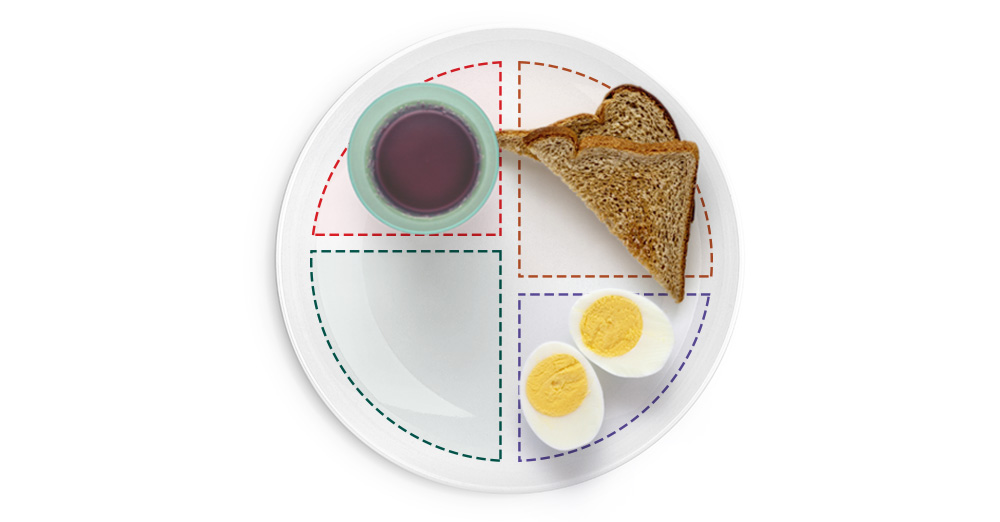
1 slice whole grain toast
1 hard-boiled egg
Lunch
½ cup large, sliced strawberries
1 cup sliced carrots
1 cup water
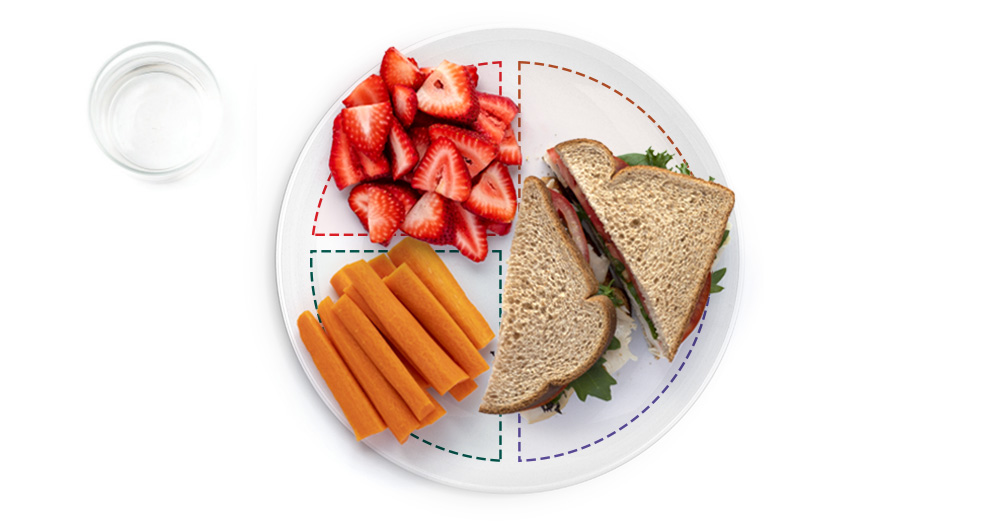
2 slices whole grain bread
with 3 ounces lean deli turkey
with ¼ cup lettuce and ¼ cup tomato
Snacks

½ cup sliced peaches
1 cup low-fat or non-fat milk
5 or 6 whole grain crackers
3 or 4 slices cheese
½ cup sliced cucumbers and ½ cup cherry tomatoes
water between meals and snacks
Dinner
1 cup grapes
½ cup cooked green beans
1 cup mixed, green salad with 1 tablespoon dressing
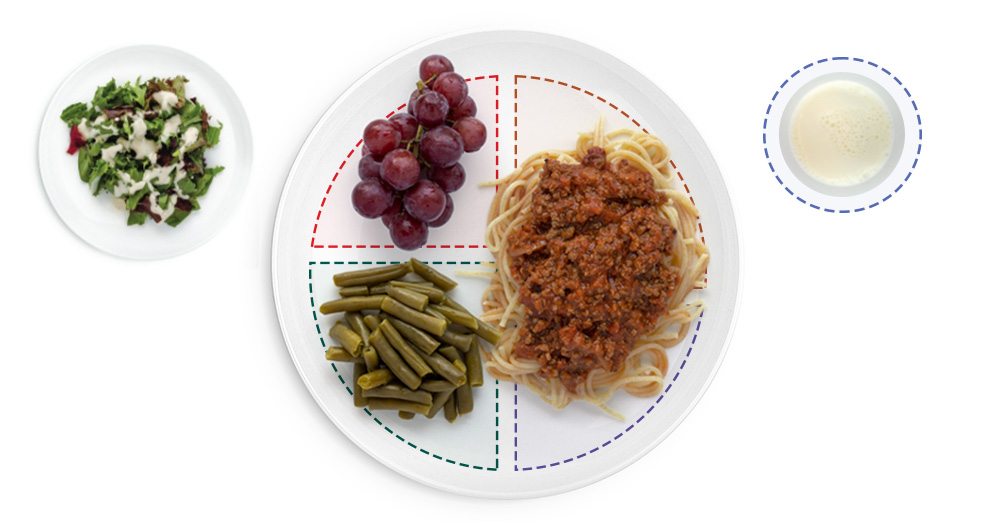
1 cup whole grain spaghetti
with ¼ cup ground beef
with 1 cup tomato sauce
1 cup low-fat or non-fat milk
Breakfast Ideas
Make time for breakfast. It helps you get through the day. Here are a few ideas. Choose one or more foods from each group below.
BREAD, CEREAL, OR OTHER GRAINS
- Bagel
- Cereal
- Whole wheat or corn tortilla
- Crackers
- English muffin
- Oatmeal or grits
- Raisin bread
-
Whole grain bread
- Granola or trail mix
- Whole grain waffle
DAIRY OR PROTEIN
- Low-fat milk
- Low-fat cheese
- Low-fat yogurt
- Egg, cooked
- Nuts (like walnuts)
-
Peanut butter or nut butter
- Hummus
FRUIT OR VEGETABLE
- Applesauce
- Green peppers
- Tomato
- Avocado
-
Apple
- Banana
- Melon
- Orange
- Peach
- Pineapple
- Raisins
- Strawberries
Be Smart About Fast Foods
ON THE GO? ASK FOR THESE SMART CHOICES – AND DON’T SUPERSIZE.
- Grilled chicken sandwich
- Turkey and avocado sub
- Hamburger or cheeseburger
- Pizza topped with green peppers, tomatoes and mushrooms
- Baked potato with vegetable and cheese toppings
- Bean burrito
- Fruit
- Water, low-fat milk or 100% juice
Get Folic Acid Every Day.
Check nutrition labels to get enough folic acid each day.
- Take a vitamin that has 400 mcg folic acid in it every day.
- Eat a bowl of breakfast cereal that has 100% of the daily value of folic acid every day.
Eat foods with folic acid even if you take a vitamin pill or eat fortified cereal.
- Add some cantaloupe, oranges or strawberries to your breakfast.
- Choose darker green lettuce and greens, like romaine, green leaf or raw spinach for salads or sandwiches.
- Have peanuts for a snack.
- Mix up a great tasting dip and use cut up raw veggies, like broccoli and cauliflower or use cherry tomatoes and mini carrots for dipping.
If you eat fortified cereal, read the label.
- The cereal should give you 100% of the Daily Value. This means it has 400 mcg of folic acid.
If you take a vitamin pill, read the label.
- The pill should have 400 mcg of folic acid.
What about iron?
- After childbirth, your body’s iron level may be low. This can make you feel weak and tired. Your healthcare provider may recommend a vitamin with iron or to continue taking your prenatal vitamin.
TRY TO EAT MORE OF THESE IRON-RICH FOODS:
- Iron-fortified breakfast cereal
- Cooked dried beans like white beans, lentils, garbanzo beans or pinto beans
- Lean red meat
- Tofu
- Eggs
- Greens like spinach, collard greens and mustard greens
- Potato with skin
- Prune juice
- Whole grain bread
Small Changes and Healthy Choices Add Up To A Healthier You!
- Don’t eat food directly from the package – portion out foods, like crackers, nuts, trail mix, pretzels, cheese cubes, etc., into individual containers or zip-top bags. Better yet, put vegetables in a container for quick healthy snacks without all the calories.
- Leave some food in the kitchen at mealtimes – serve lower calorie vegetables and salads family-style at the table and serve the main dish in the kitchen.
- Stop eating when you feel full – remind yourself that it’s okay to stop eating before your plate is empty or before everyone is done eating.
- Watch your portions – use smaller plates and put less on your plate. Studies show we eat more when there’s more to eat.
- Cut back on some foods – cut calories by cutting out foods high in fats and added sugar. Decide to choose sweet drinks, cookies, cakes, candies and ice cream as occasional treats. Limit meats, like ribs, bacon and hot dogs.
- Cook at home – try healthier recipes that use less fat, sugar and salt.
- Drink water – keep water with you throughout the day. Sipping water can help fill you up so you don’t eat as much.
- Eating healthy is only one part of feeling great and having more energy – being active helps too.
- Staying active helps new moms relieve stress – and having a new baby can be stressful!
Ask your doctor when it’s okay to exercise and then start out slow.

Be Active Whenever you Can
Your body stays fit when you move it. If your healthcare provider says it’s okay, stay active. Walking and swimming are two good ways.
Being physically active can:
- help you look and feel great
- give you more energy
- lower stress and help you relax
- work off your pregnancy weight
- tone your muscles
Take it easy, at first. Your body needs to heal. Ask your healthcare provider what you can do and when you can do it.
Start with a 5 or 10 minute walk. After one week, walk a little longer or farther. Set a goal that works for you.
Here are other easy ways to move your body:
- March in place when you watch TV or talk on the phone.
- Play music and dance.
- Ask your friends and family to join you.
Change health habits one at a time.
Get used to one change before you make the next one.What food can you cut back on?
Example:
Cut back to one soda a day.
What food can
you change?
Example:
Eat low-fat yogurt
for breakfast.
What can you do to be more active?
Example:
Take the stairs, not the elevator.
Make Time For Yourself
Enjoy your new baby, but take care of yourself, too.
- Ask for help from family and friends. Let them shop, cook and clean.
- Nap when your baby naps. If you can’t sleep, lie down and rest.
- Find someone to talk to.
POSTPARTUM DEPRESSION
Many new moms get the blues. They cry, feel sad and have mood swings. The blues can last up to 2 weeks. If the feelings get worse, you could have depression.
If you think you might have postpartum depression, talk with your healthcare provider to get help. Untreated depression is hard on your baby, your family and you.
If you have thoughts of harming yourself or your baby, get immediate help.
Call 1-800-273-8255 for free and confidential emotional support 24 hours a day, 7 days a week. You can also dial 988.
SIGNS OF POSTPARTUM DEPRESSION
Any of these feelings that last more than 2 weeks:
- Feeling very sad
- Crying all the time
- Don’t want to eat or can’t stop eating
- Can’t sleep or want to sleep all the time
- Don’t want to take care of yourself
- Don’t enjoy life
- Don’t care about your baby
- Feel like you could hurt yourself or your baby
- Afraid to be alone with your baby
- Worrying too much about your baby


TRY THIS STRESS RELIEVER
- Sit in a chair.
- Put your hands on your stomach.
- Breathe in through your nose as you slowly count to 4. Hold for one second.
- Breathe out through your mouth as you slowly count to 4. Repeat 5 to 10 times.
KEEP YOUR SMILE HEALTHY.
Healthy teeth and gums are a sign of good health.
- Brush your teeth (and tongue) at least 2 times a day.
- Floss your teeth every day.
- Drink water, not sugar-sweetened drinks.
- Get a dental checkup every 6 months.

Understanding Your Baby’s Cues
Your baby uses body movements and cues to tell you what they need. Responding to your baby’s cues can help them be calm and happy.
“I’M HUNGRY”

When I’m starting to get hungry, I might:
- Keep their hands near their mouth
- Bend their arms and legs
- Make sucking noises
- Pucker their lips
- Search for the nipple (roots)
“I’M Full”

When I’m feeling full, I might:
- Suck slower or stop sucking
- Relax their hands and arms
- Turn away from the nipple
- Push away
- Fall asleep
“I WANT TO BE NEAR YOU”

As your newborn gets older, you will be better able to tell when they are ready to interact, learn or play.
When your baby is asking you to help them learn more about you and their new world, they may:
- Have a relaxed face and body
- Follow your voice and face
- Reach toward you
- Stare at your face
- Raise their head
“I NEED SOMETHING TO BE DIFFERENT”

As you get to know your baby, you will begin to learn what they are trying to tell you. This takes time.
When your baby needs a break from playing and learning, or needs some quiet time, they may:
- Look away, turn away or arch their back
- Frown or have a glazed look in their eyes
- Stiffen their hands, arms or legs
- Yawn or fall asleep
Give Your Baby the Best Start – Breastfeed!
EAT THREE MEALS AND AT LEAST ONE SNACK EACH DAY. SOME SNACK IDEAS ARE:
- Cheese and crackers
- Fruit
- Low-fat yogurt
- Nuts and raisins
- Cereal
- Sandwich
If you do not drink milk, talk to wic. You can get alcium from other foods like:
- Cheese
- Yogurt
- Orange juice with calcium
- Tofu (made with calcium)
- Kale and collard greens
- Other foods fortified with calcium
Join a breastfeeding support group where you can talk with other moms.
Call WIC or a lactation consultant if you have questions about breastfeeding.
BREASTFEEDING – GOOD FOR YOU, GOOD FOR BABY
Did you know?
Breastfeeding may help lower your risk for type 2 diabetes, and breast and ovarian cancers.
Babies who are NOT breastfed:
- Have more allergies
- Are sick more often
- Have more diarrhea and constipation
- Have a greater risk of crib death (SIDS)
Moms who do NOT breastfeed:
- Spend more money on food for baby
- Take longer to get back into shape
- Are more likely to get certain cancers


FOR FORMULA FEEDING MOMS:
Whether you choose to feed your baby breast milk or formula, your baby counts on you to help them do well eating.
- Mixing formula is just like following a recipe; mixing ingredients correctly is important. Your baby needs you to follow mixing directions on the can.
- If others care for your baby, be sure they know how to correctly mix and prepare the formula.
- Throw away formula left in the bottle after a feeding. If you prepare bottles ahead, store them in a refrigerator until you are ready to feed your baby. Prepare just enough bottles for 24 hours.
- Formula heated in a microwave can burn your baby’s mouth. Warm the bottle in hot water. The bottle should feel lukewarm – not hot.
- Your baby only needs formula in the bottle; never put sweetened drinks or water in your baby’s bottle.
Staying Safe
You and your baby can get hurt from tobacco, alcohol and other drugs.
If you get pregnant again, your baby could be born too small or exposed to substances and suffer painful withdrawal.
Tobacco smoke can:
- Make your baby have more colds and ear infections.
- Lead to asthma or make asthma worse.
- Lead to cancer, heart disease or stroke.
Set a “NO SMOKING” rule for your home. Don’t let people smoke around you or your baby.
Stay away from alcohol and drugs.
Never leave your child with people who drink too much or use drugs.
Say NO to:
- Beer
- Smokeless tobacco
- PCP or angel dust
- Wine
- Misuse of medicines
- Heroin
- Mixed drinks
- Marijuana
- Methamphetamines
- Liquor
- Crack/cocaine
- Opioids
- Cigarettes
- LSD
- Vape and Juul products
Feeding a 6-7 Month Old
Continue to nurse on-demand, about 4-6 times in 24 hours.
Babies may experience a growth spurt around 6 months of age and may feed more often.
Offer breast milk in a cup.
24-32 oz. per day of infant formula.
Offer formula in a cup.
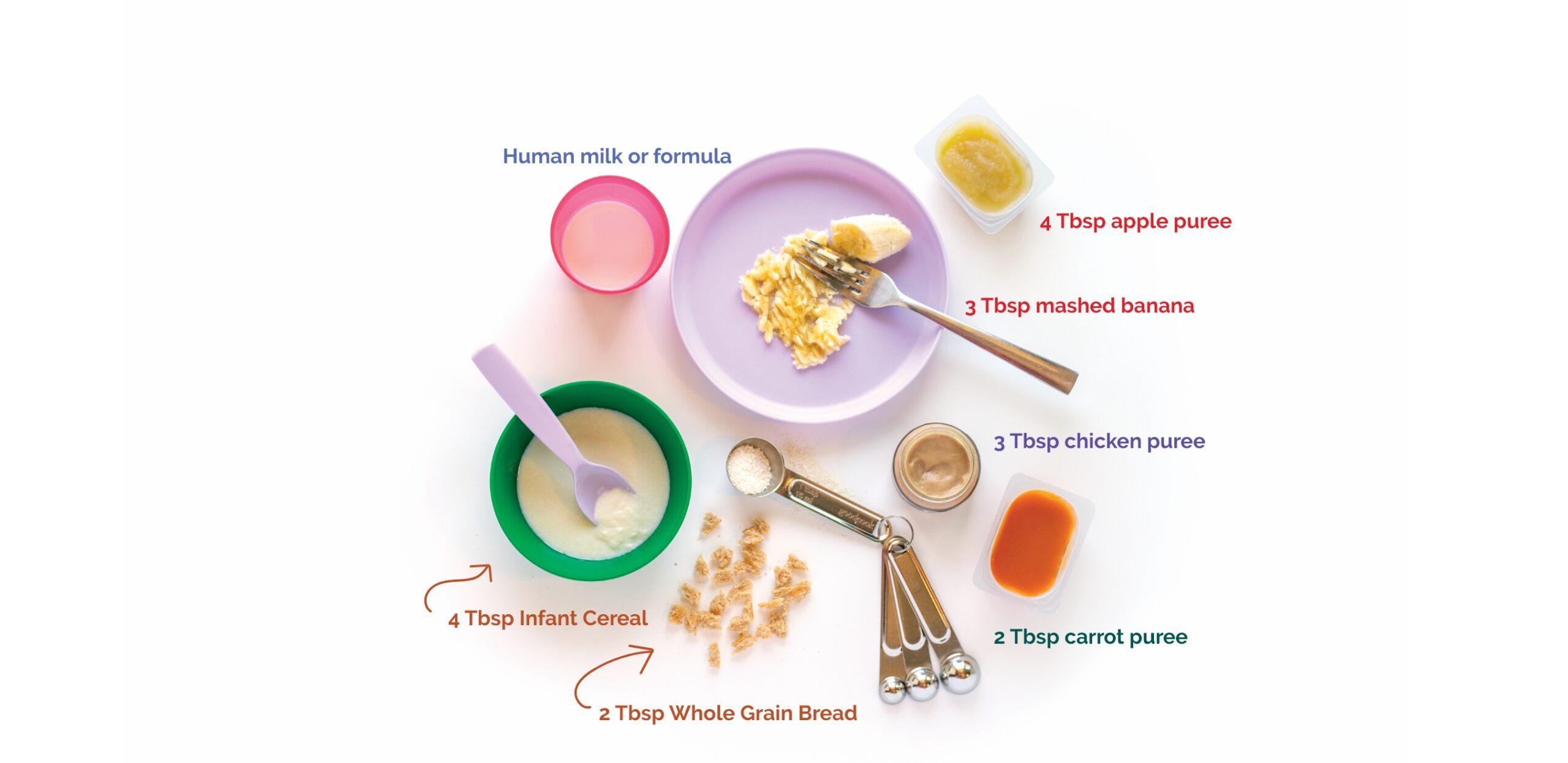
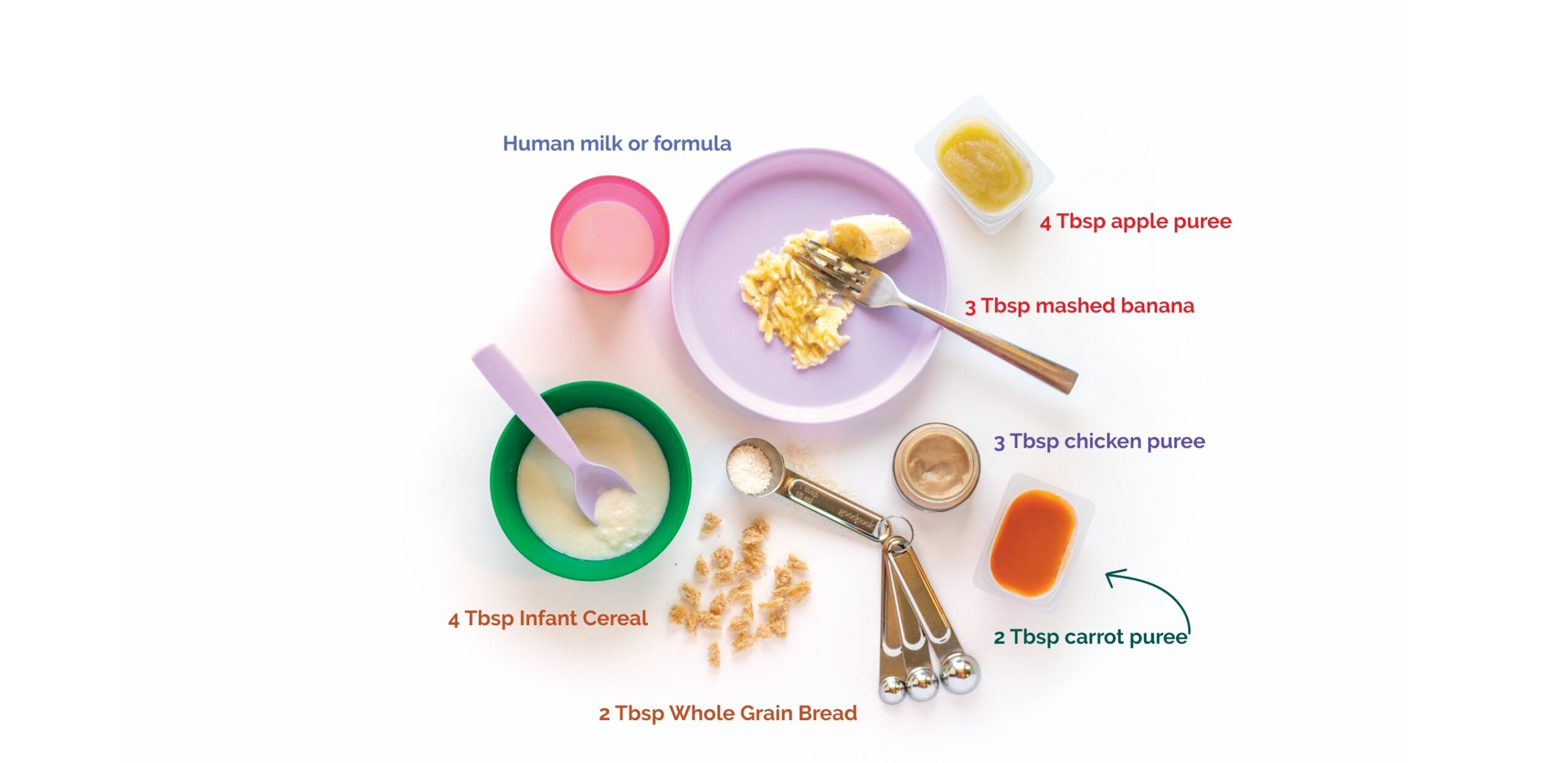
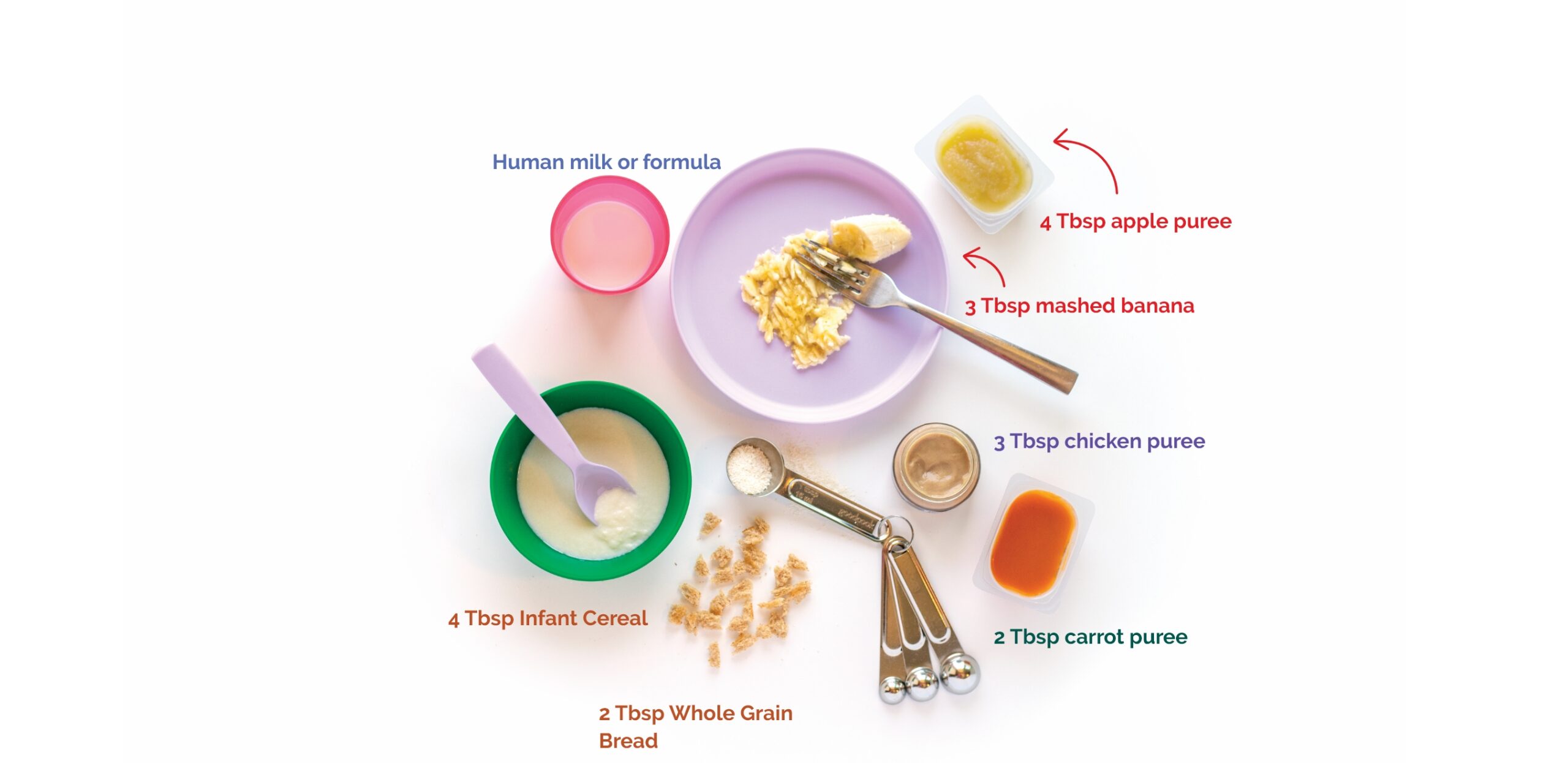
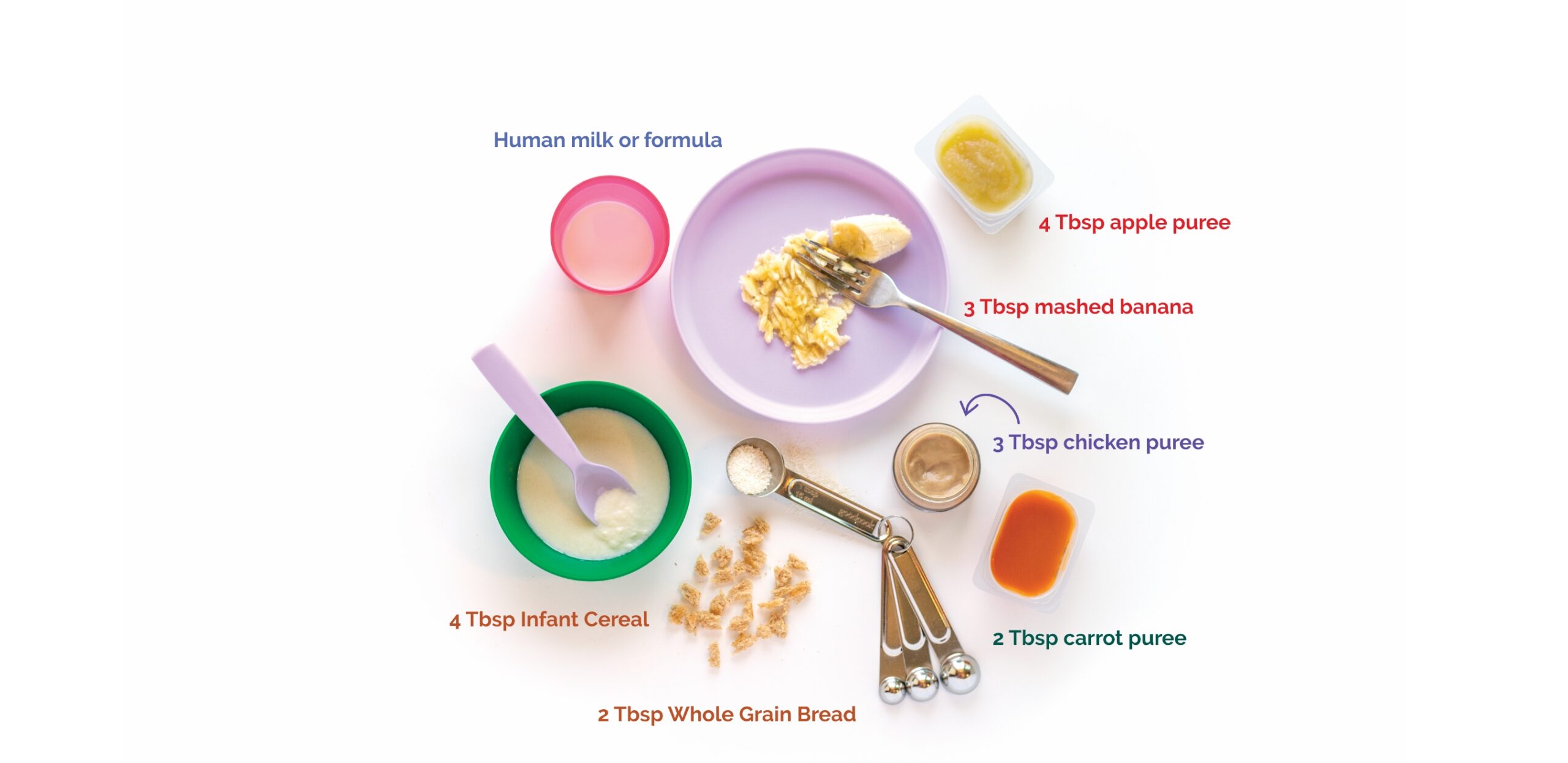
Feeding a 10-12 Month Old
Breast milk is the most important source of nutrition for your baby, even after you start offering solid foods.
Continue to nurse on-demand, 3 or more times per day.
16-24 oz. per day. Offer in a cup.
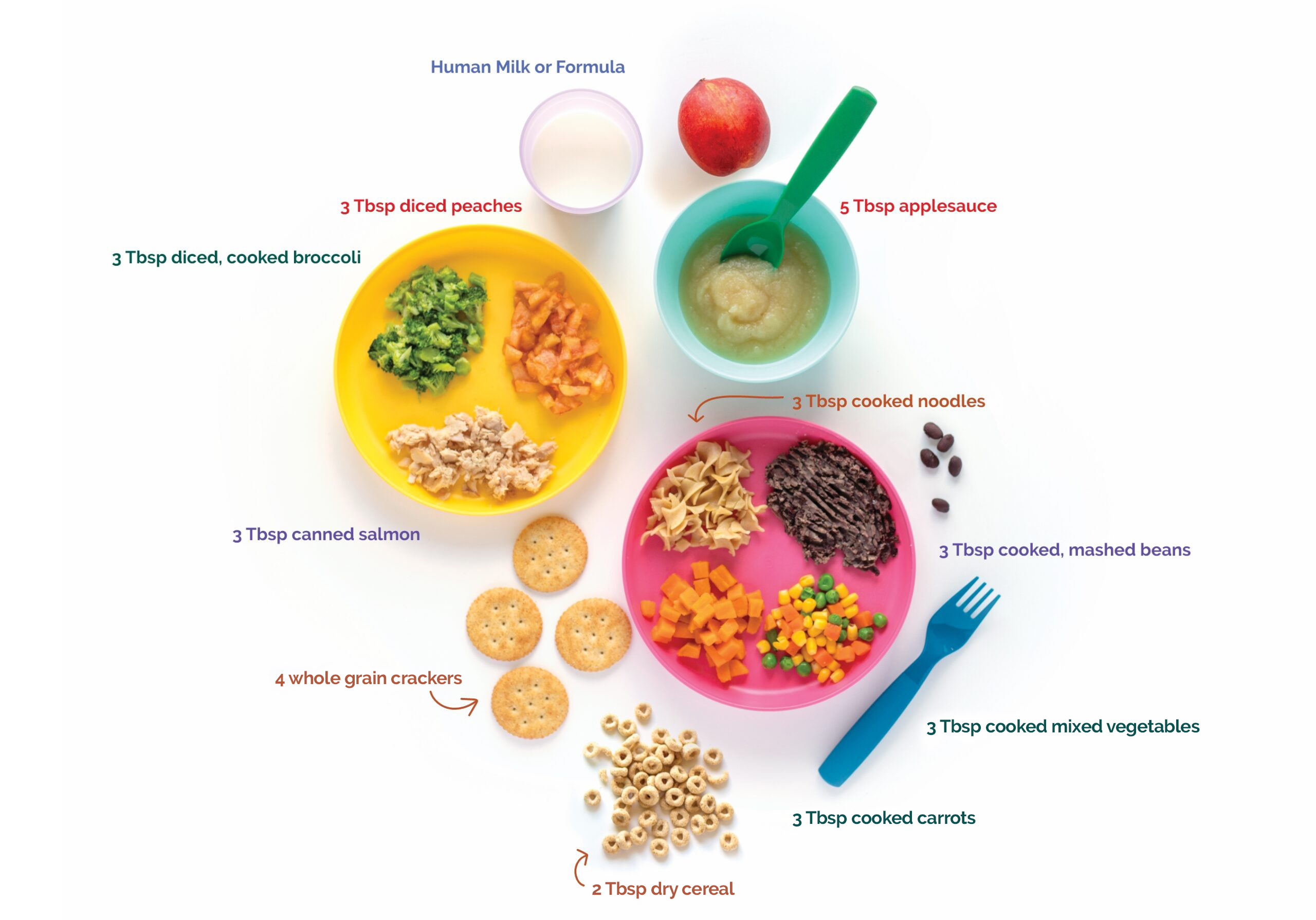

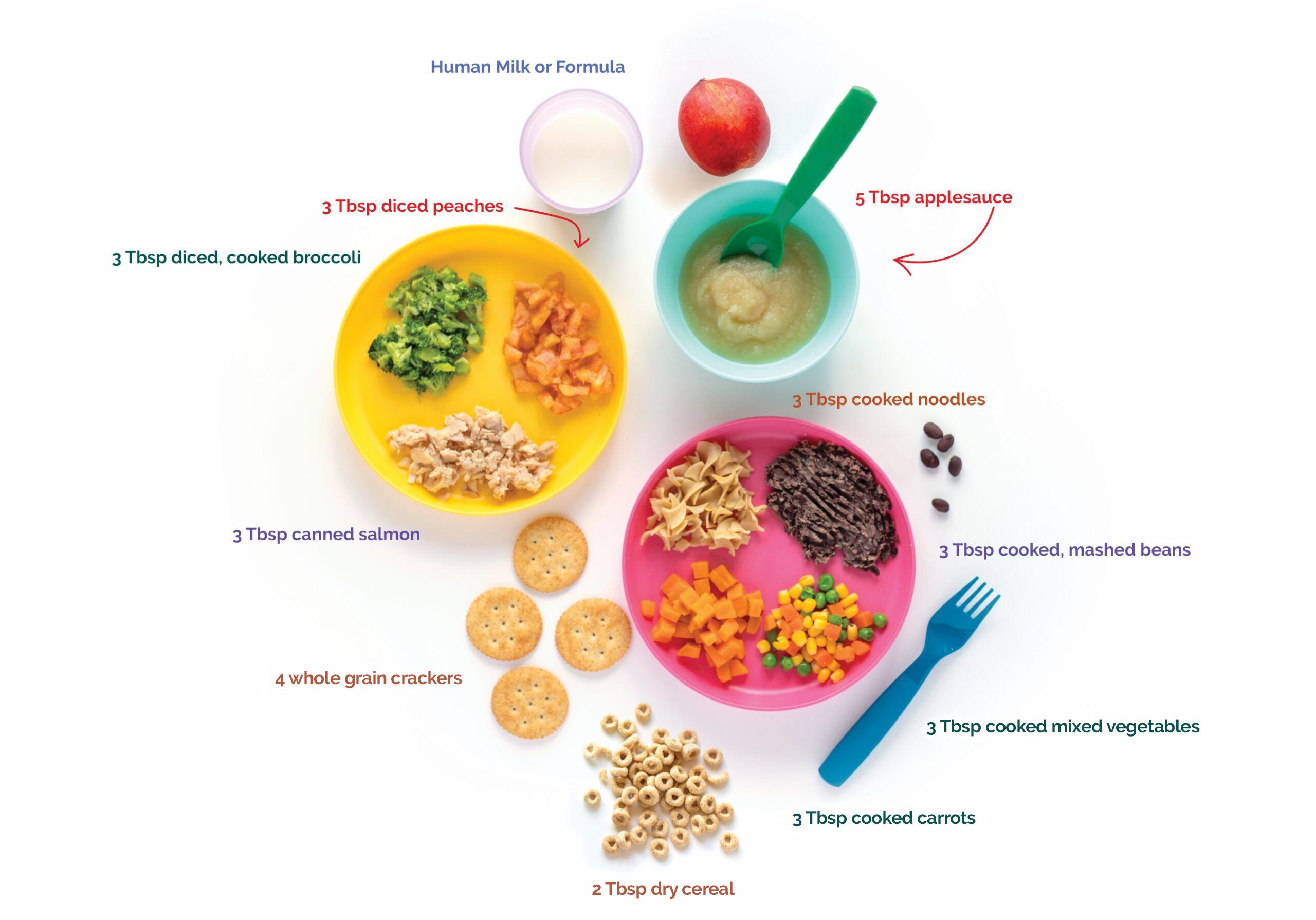
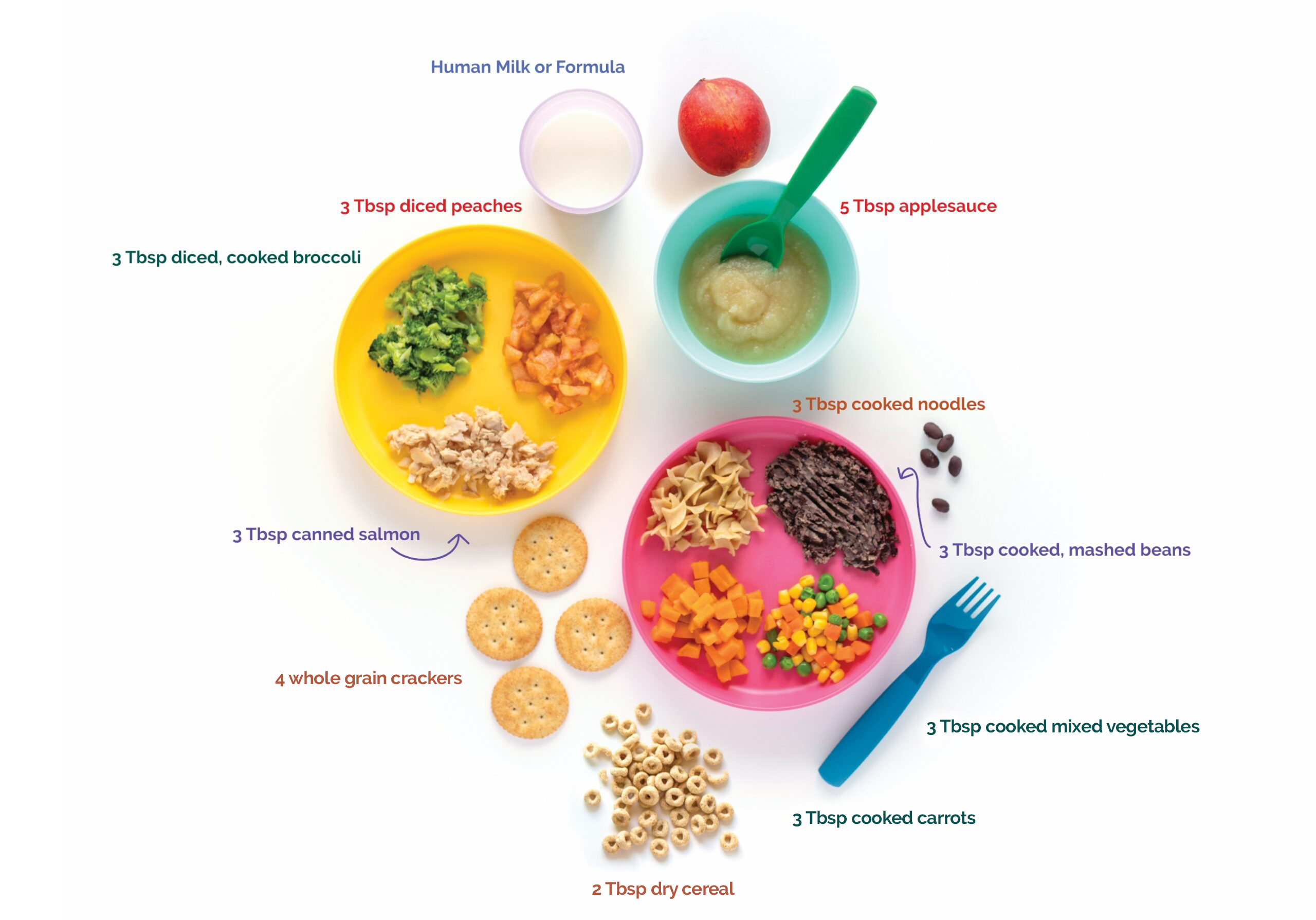
Feeding a 8-9 Month Old
Feed solids with a spoon. Never put cereal in a bottle.
Continue nursing on-demand, at least 4 times in 24 hours.
If your baby seems less interested in nursing after you introduce solids, try nursing before you offer solids.
Offer breast milk in a cup.
24-32 oz. per day.
Offer formula in a cup.
4-8 Tbsp. per day.
Plain iron-fortified infant cereals.
Plain rice or pasta.
Baby crackers, small pieces of bread, or soft tortillas.
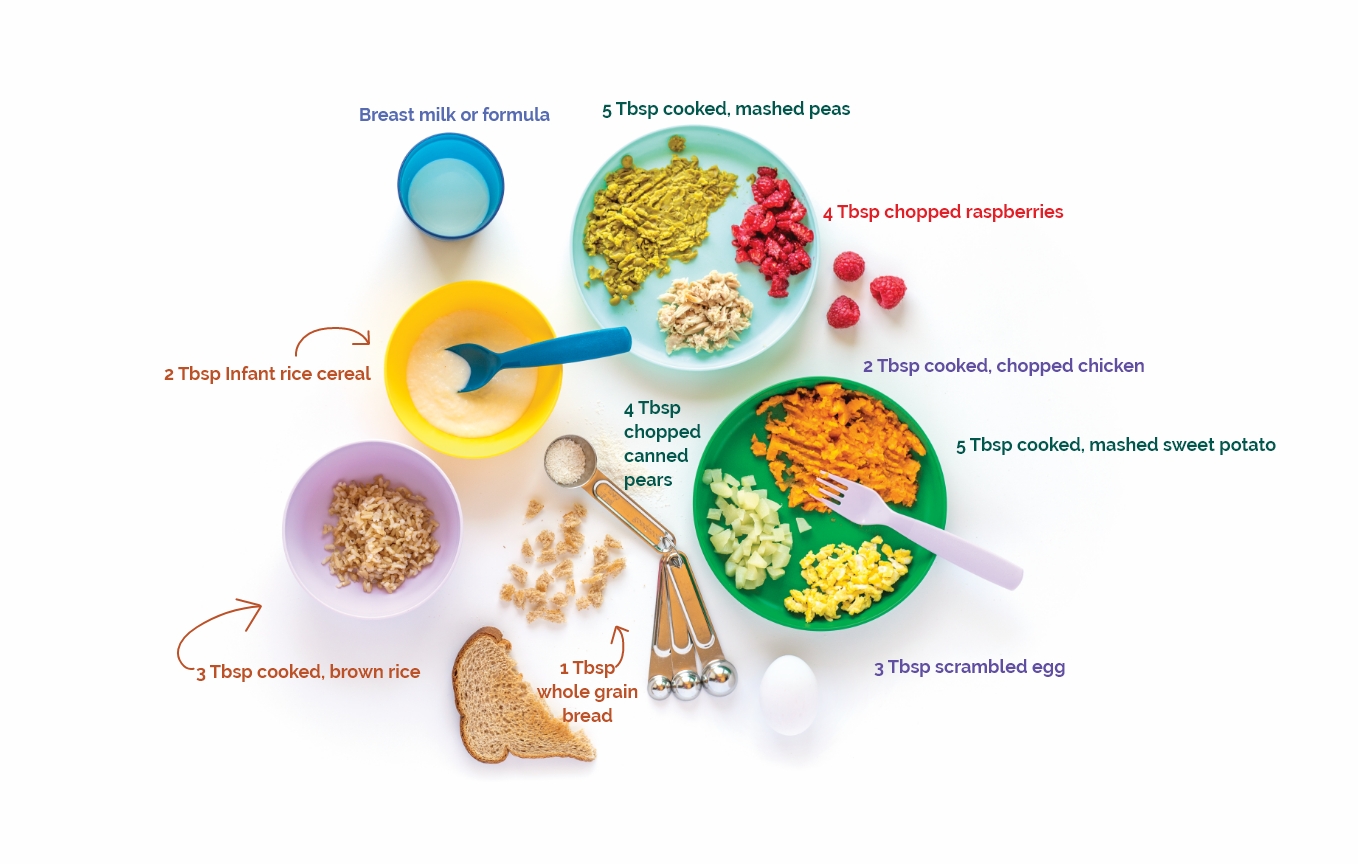
8-12 Tbsp. per day.
Plain cooked vegetables, mashed with a fork.
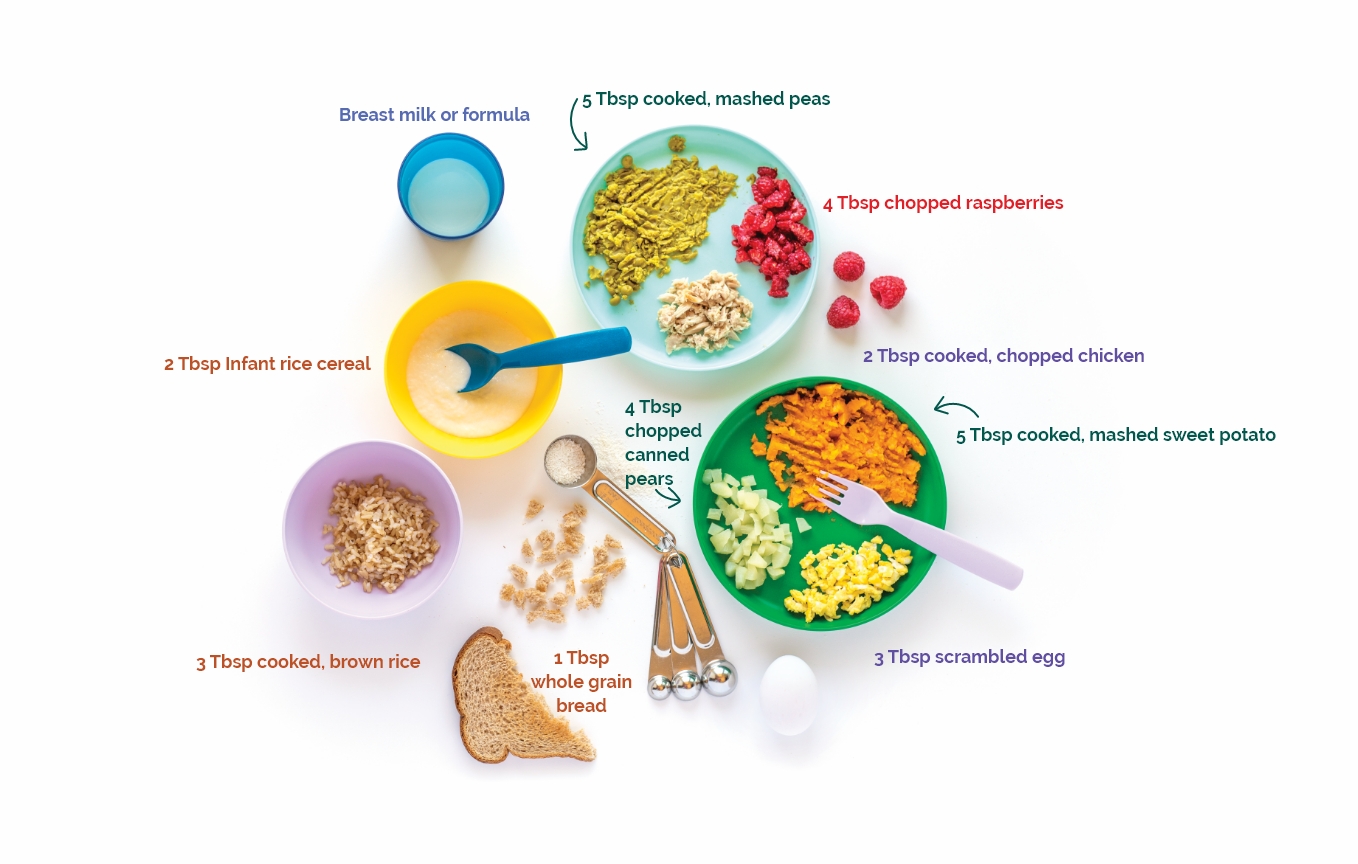
8-12 Tbsp. per day.
Peeled soft fruit in bite-size pieces.
Unsweetened canned fruit.
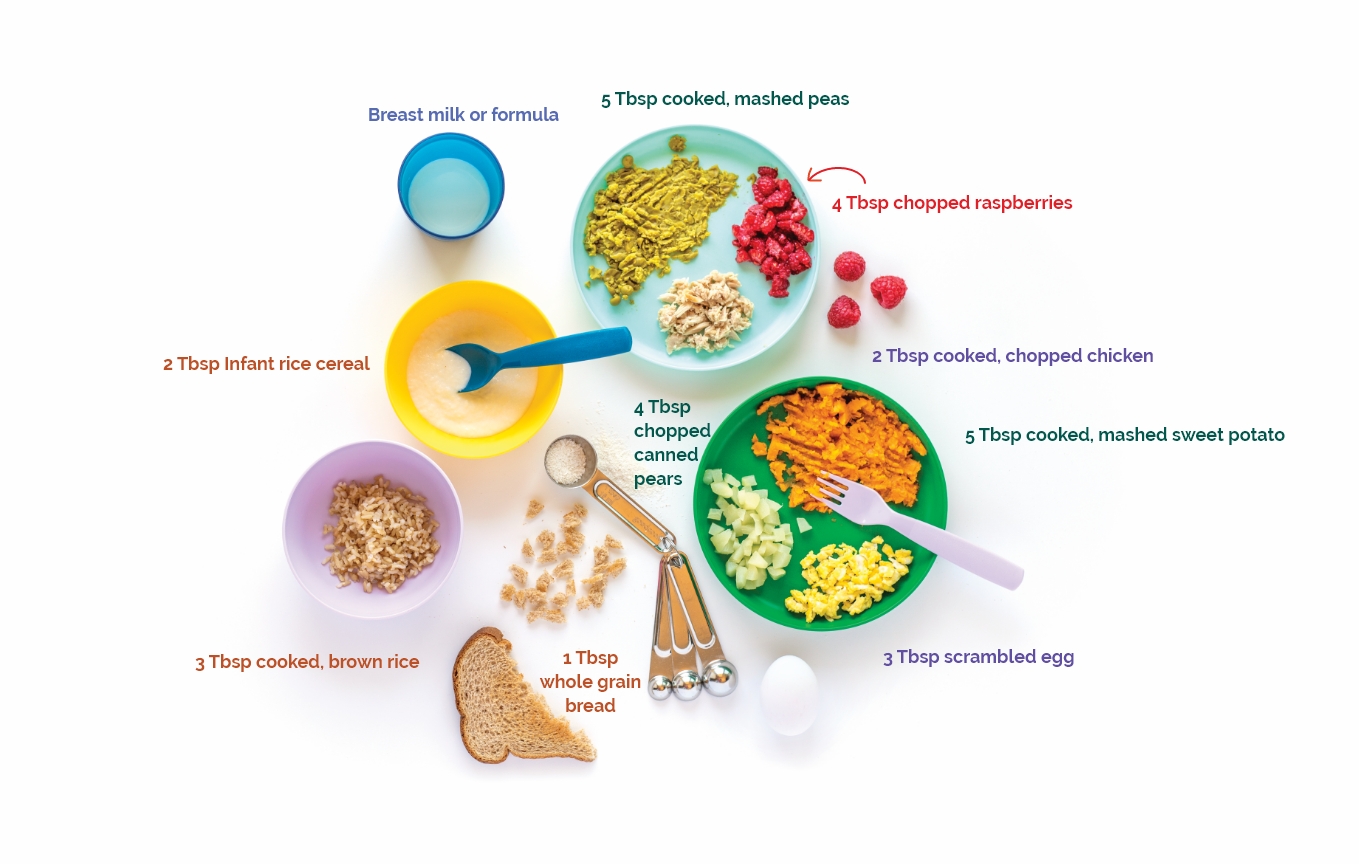
4-8 Tbsp. per day.
Finely ground, chopped, or diced meats, poultry, eggs, fish, or cooked mashed beans.
Cottage cheese or mild cheese.
Thinned, smooth peanut or nut butter.
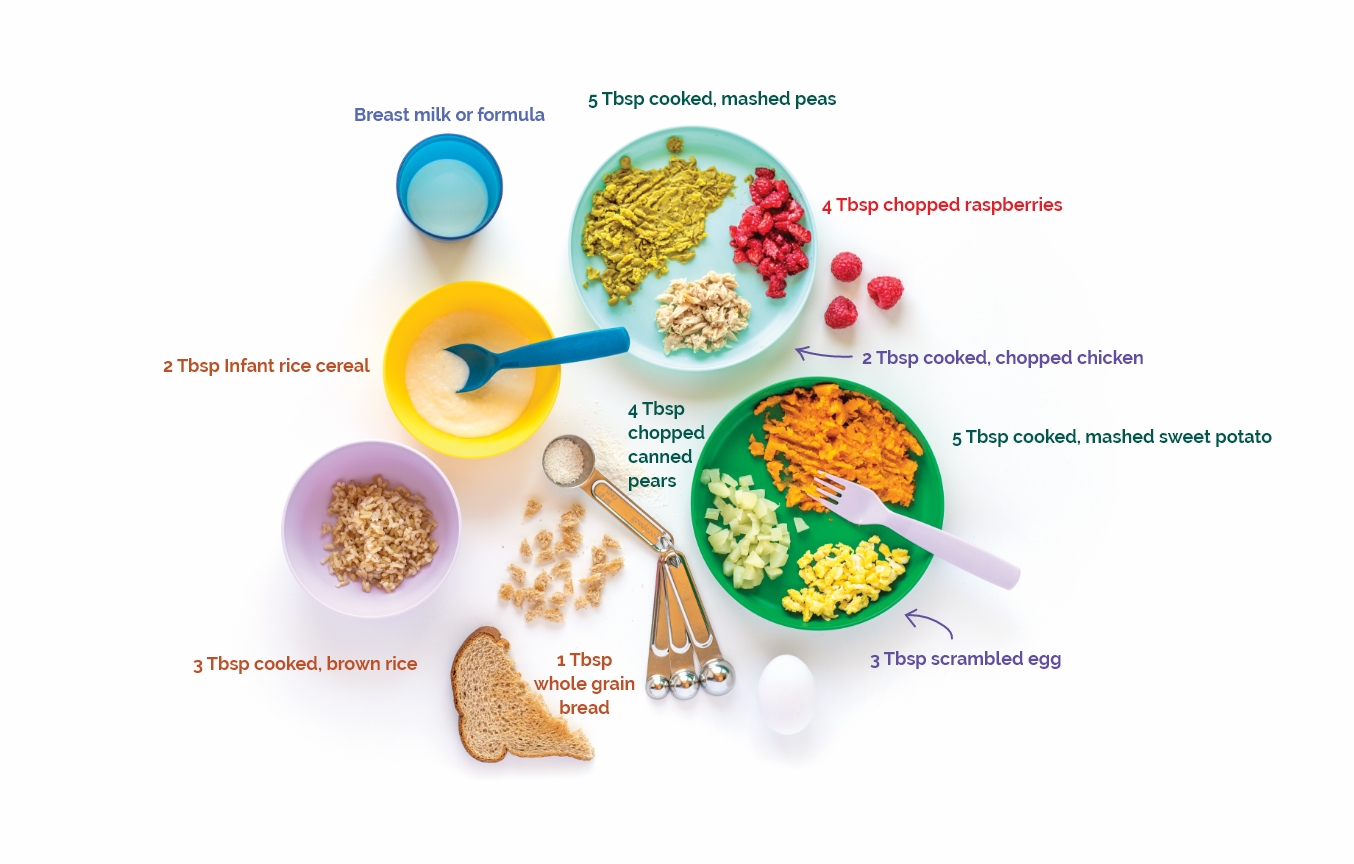
Tips

Breast milk and formula feeding:
Around 2-3 weeks, 6 weeks, 3 months, and 6 months of age, babies may experience a growth spurt when they feed more often.
As they grow babies can hold more milk, so feedings may become further apart and take less time.
To prevent choking, always hold your baby when feeding. Never prop up a bottle to feed.
Start offering whole milk when your baby is one year old.
The American Academy of Pediatrics recommends exclusive breastfeeding for the first six months and that breastfeeding continue for at least 12 months and beyond.

Feeding solid foods:
Wait to offer solid foods until your baby:
- Can sit up and hold up their own head.
- Opens their mouth when they see food.
- Can close their lips around a spoon.
To prevent choking, always hold your baby when feeding. Never prop up a bottle to feed.
Try one new food at a time. Wait 5 days before trying another new food to watch for allergies. Food allergies may include wheezing, rash, or diarrhea.
Introduce peanut butter around 6 months. Spread a small, thin smear of peanut butter or nut butter thinly on a cracker. Watch your baby for any reaction for the next 2 hours.
Babies under one year should NOT have honey due to the risk of botulism. Also, babies should not have foods that can cause choking like nuts or whole grapes.
All babies are different. Talk with WIC or your baby’s healthcare provider about your baby’s needs.
Feeding Cues
-
 Stirring
Stirring -
 Mouth opening
Mouth opening -
 Turning head seeking/rooting
Turning head seeking/rooting
-
 Releases or “falls off”
Releases or “falls off” -
 Turns away
Turns away -
 Relaxes and opens fists
Relaxes and opens fists
Feeding a 4-5 Month Old
Before teeth come in, wipe gums with a soft, clean wash cloth after each feeding, especially before bed.
Nurse your baby on-demand, at least 7-9 times in 24 hours.
When your baby starts teething, they may want to nurse more often.
25-45 oz in 24 hours.
Your baby needs about 4-6 oz of iron-fortified formula every 3-4 hours.
Your baby may start to feed on a schedule. Instead of focusing on fixed amounts, let your baby tell you when they have had enough.
Feeding a 0-3 Month Old
Newborns have tiny tummies and need to be fed often. In the first few weeks, you may need to wake your baby to feed if they sleep longer than 4 hours.
Growth Spurts
Many babies are fussy during a growth spurt and will want to nurse longer and more often. This is called cluster feeding. This is your baby’s way of helping you increase your milk supply so that you can keep up with their needs. Remember, the more your baby nurses, the more milk your body makes.
Growth spurts can happen at any time, and every baby is different.
They often happen at these ages:

2 to 3 Weeks

6 Weeks

3 Months

6 Months
Breastfeed 8-12 times in 24 hours to help your newborn stay healthy.
Nurse on-demand and when your newborn shows signs of hunger, such as sucking on hands or smacking lips.
In the first few days, newborns need 2-3 oz. of iron-fortified infant formula every 3-4 hours.
By the end of the first month, your newborn needs about 4 oz. every 4 hours.
Feed on-demand and when your newborn shows signs of hunger.